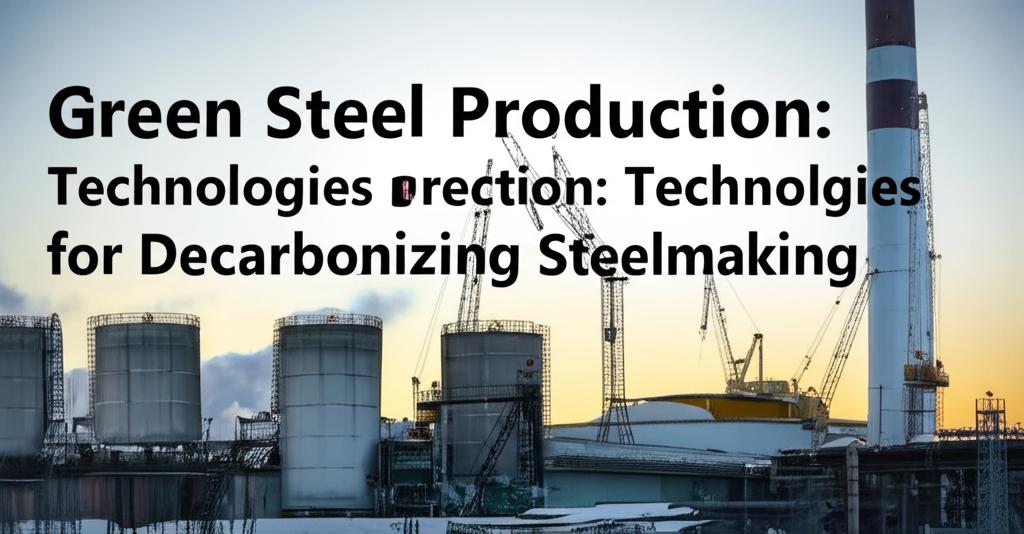The steel industry, a foundation of modern society, faces a critical challenge: its significant carbon footprint. Accounting for roughly 7-11% of global CO2 emissions, traditional steelmaking, heavily reliant on coal, must transform to meet climate goals. This transformation is driving innovation towards "green steel" – steel produced using methods that drastically reduce or eliminate greenhouse gas emissions.
Leading Technologies for Greener SteelSeveral key technologies are paving the way for decarbonized steel production:
- Hydrogen-Based Direct Reduction (H2-DRI) with Electric Arc Furnaces (EAF): This is emerging as a primary route for near-zero emission steel. Instead of using coal or natural gas, this process uses hydrogen (ideally "green" hydrogen produced via electrolysis powered by renewable energy) to remove oxygen from iron ore, creating Direct Reduced Iron (DRI), often called sponge iron. The main byproduct is water vapor, not CO2. This DRI is then melted in an Electric Arc Furnace (EAF), powered by renewable electricity, to produce steel. Numerous projects globally are implementing or planning H2-DRI plants.
- Scrap-Based Electric Arc Furnaces (EAFs): Utilizing steel scrap is a cornerstone of decarbonization. Steel is infinitely recyclable without loss of quality. EAFs melt scrap steel using high-power electric arcs. When powered by renewable electricity, this route can reduce emissions by 75-80% compared to traditional methods. Enhancing scrap collection, sorting, and processing, alongside using EAFs, is crucial for increasing secondary steel production. Many countries are increasing their EAF capacity.
- Emerging and Complementary Processes:
Electrolysis: Technologies like Molten Oxide Electrolysis aim to directly separate iron from ore using electricity, bypassing the need for carbon reductants altogether. Electrolysis is also fundamental for producing the green hydrogen needed for H2-DRI.
Ammonia as a Reductant: Green ammonia, produced from green hydrogen, can also serve as reducing agent in the direct reduction process, offering an alternative pathway that leverages existing technologies and may be easier to transport than pure hydrogen.
Process Efficiency and Digitalization: Optimizing downstream processes like continuous casting and rolling can save energy. Implementing digital tools, sensors, and AI can enhance overall efficiency, reduce waste, and optimize energy consumption throughout the production chain.
Biomass: Utilizing sustainable biomass can potentially replace some fossil fuels in specific parts of the process.
Transitional Approaches: Carbon Capture (CCUS)Carbon Capture, Utilization, and Storage (CCUS) involves capturing CO2 emissions from emission sources (like existing blast furnaces or power plants within a steel mill) and either storing it underground (CCS) or using it to create other products (CCU). While it offers a potential way to reduce emissions from existing, hard-to-abate facilities, its application in the steel sector faces challenges. Issues include high costs, the energy required for capture, the need for multiple capture points at complex integrated plants, and questions around long-term effectiveness and storage viability. Currently, there are very few operational large-scale CCUS projects in the steel industry, and its role is often seen as transitional or limited compared to H2-DRI or scrap-EAF routes.
Overcoming the HurdlesThe transition to green steel is not without obstacles:
- Cost: Green hydrogen and the renewable electricity needed are currently expensive compared to fossil fuels, making green steel production costly.
- Infrastructure: Massive investment is required in renewable energy generation capacity and green hydrogen production/transport infrastructure.
- Raw Materials: Ensuring sufficient supply of high-grade iron ore suitable for DRI processes and availability of high-quality scrap steel are key considerations.
- Scaling Technology: While technologies exist, scaling them up to meet global steel demand requires significant effort and investment.
- Policy Support: Clear government policies, supportive regulations, carbon pricing mechanisms, and international standards are needed to drive investment and create a level playing field.
Decarbonizing steelmaking requires a comprehensive, "dual decarbonization" strategy – simultaneously tackling emissions from primary steel production (using iron ore) via routes like H2-DRI, while also maximizing the use of recycled scrap in EAFs powered by clean energy. While challenges remain, significant investments are being made, pioneering projects are coming online, and technological innovation continues. Achieving green steel production is essential for global climate ambitions and represents a major transformation for this vital industry.

